Trdelník: The Czech food that's not Czech
 Alamy
AlamyIn recent years, this doughy, sugar-coated sweet has become ubiquitous in Prague. But despite being billed as "traditionally" Czech, the dish was adopted from elsewhere.
In February 2023, newly-minted United States ambassador to the Czech Republic, Bijan Sabet, uploaded some of his first photos as ambassador to Instagram. The now-deleted post included a couple of shots of cobblestone streets near the US Embassy in Prague and a photo of him holding an ice cream-topped trdelník, a popular tube-shaped pastry.
The next day, the Czech press jumped on the photo of the trdelník. "The first mistake of the new American ambassador", read the headline in the daily newspaper Mlada Fronta Dnes. Another Czech newspaper, Lidove Noviny, put it in the spectrum of American political scandals by calling it "TrdelníkGate".
So, what was all the fuss about and how did a pastry cause an international political scandal?
If you join the army of tourists in Prague's historical centre, you'll notice that every third or fourth shop – particularly between Old Town Square and Charles Bridge – features 15cm (6in) tubes of dough slowly spinning horizontally on a stick over burning charcoal and a sign above it proclaiming "Old Czech Specialty". The scent of caramelised sugar and baked dough wafts from these shops, and at each one, there is often a line out the door.
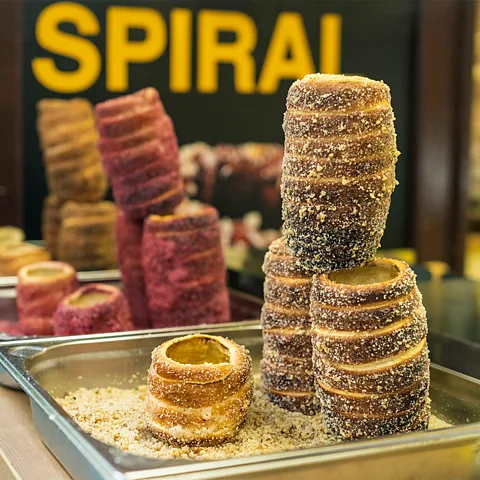 Ivana Larrosa
Ivana LarrosaMeet the trdelník. Also called "chimney cakes", perhaps because they are long-ish and tubular, trdelník gets its name from the stick it slowly spins on as it cooks over coals (trdlo means "stick" in Czech).
When I lived in Prague for three years in the 1990s, there were no signs of the trdelník (pronounced: "ter-del-neek"). But starting around 2010, I began seeing more and more shops and street stalls selling them. Employees were dressed in historical garb and signs boasted of the pastry's Czech origins. Search for "Prague" or "trdelník" on TikTok or Instagram and you'll find legions of influencers raving about this "traditional Czech pastry".
The issue is that the trdelník isn't Czech: it's a sugar-coated riddle wrapped in a doughy mystery inside an ice cream-topped enigma of nebulous origins that tourists appear to love. At the same time, many locals say travellers to their country are being duped into thinking they're indulging in something inherently Czech. On a recent visit to Prague, I decided to try to peel back the flaky dough of the trdelník in order to understand this culinary conundrum and how it came to be a favourite "old Czech specialty" among the tourist masses.
According to a Romanian newspaper, the first-known mention of the trdelknik is in a mid-15th-Century manuscript in Heidelberg, Germany. In 1784, it turned up in a cookbook in Transylvania. From there, it seems, the pastry slowly made its way west from Transylvania, anchoring itself throughout Hungary where today it's called kürtöskalács, and eventually finding a warm welcome in the Slovakian town of Skalica. The fact that Skalica became part of Czechoslovakia might partly explain how the pastry ended up catching the attention of Czechs entrepreneurs decades later.
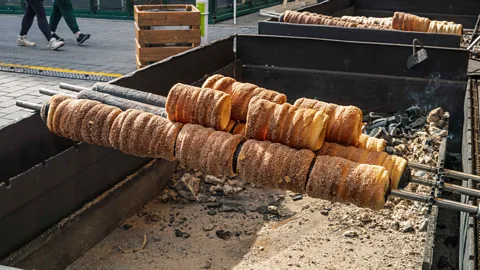 Ivana Larrosa
Ivana LarrosaThe first trdelník shop in the Czech Republic didn't fire up its dough-cooking coals until 2004, when Martin Figura opened a bakery in the country's eastern Moravia region. On his business's website, he claims the pastry comes from Hungary. A year later, another baker, Martin Švarc, opened a trdelník stand in the southern Bohemian tourist town of Česky Krumlov in 2005.
"These people inspired me, and I copied their business," he told me, referring to the first few people who opened up trdelník bakeries in the country. According to Švarc, trdelník shops started opening in Prague a year or two later. In 2015, someone got the brilliant idea to begin offering a scoop of ice cream on top of the dish and the city's new made-for-tourist dessert was complete.
Back in Prague, I met up with Janek Rubeš, a journalist whose YouTube channel, the Honest Guide, has 1.4 million subscribers. In his videos, he reveals some local favourites for eating and drinking in Prague, but he has also been very vocal about the trdelník, which has made him the face of anti-trdelník sentiment in his hometown.
One of the reasons why the trdelník is so popular with tourists in Prague can be boiled down to a simple and effective marketing technique. "My mom used to work for an international restaurant chain, and she used to say: if you can smell it and see it from the street, you're likely going to be enticed to try it," Rubeš said.
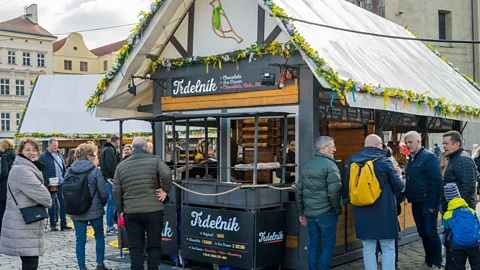 Ivana Larrosa
Ivana LarrosaRubeš isn't the only Prague resident who is annoyed by the ubiquity of the trdelník and its false association with Czech culinary culture. In December 2022, two theatre students at the Academy of Performing Arts in Prague made a trdelník-themed project. Anna Hubená, who is studying costume design, created a life-size trdelník costume for Danny Takieddin, an acting student. Scrawled in large letters on the backside of the costume was: "I AM NOT CZECH TRADITION". The two of them hit the streets of central Prague as Hubená filmed Takieddin's interactions with tourists. Sometimes the life-size trdelník with legs would be standing next to trdelník-eating tourists – most of whom didn't get the irony, thinking that the plus-sized pastry was actually promoting a trdelník shop.
"Mostly only local Czechs appreciated it," said Hubená. Takieddin added, "Even a homeless guy yelled out at us, 'It's from Romania!'"
Prague doesn't have a street food tradition. Food here, traditionally consumed in pubs, is meaty, stodgy fare that pairs nicely with a golden-hued pilsner. I can't help but feel that trdelník shop owners are reimagining Czech history for their own financial benefit. The trdelník industry is betting that most visitors to Prague won't have an extensive knowledge of Czech cuisine. Case in point: the American ambassador to the Czech Republic. "I don’t blame him," said Rubeš, of the ambassador's "TrdelníkGate" photo. "If you walk through the centre of Prague and see so many shops selling trdelník, you're going to assume it's a big part of Czech culinary culture."
It's no coincidence that as tourism numbers have grown in the Czech Republic, so have the number of trdelník shops. In 2003, 20 million foreign travellers visited the nation and there were zero trdelník shops. By 2019, just before Covid restrictions, that number had nearly doubled to 37 million. There are no statistics on the number of trdelník spots in the country, but there is no denying that the trdelník industry has shadowed the rise in tourism.
"This is a cautionary tale about how authenticity, when paired with processes of urban touristification, can become a powerful tool for commodification, deceit and appropriation of third-party food traditions – in this case Hungary, Romania and Slovakia," said Alessandro Gerosa, a professor of sociology at the University of Milan and author of The Hipster Economy: Taste and Authenticity in Late Modern Capitalism. "The hostility from local Czechs seems powerless vis-à-vis the pervasiveness of Prague's growing tourism industry."
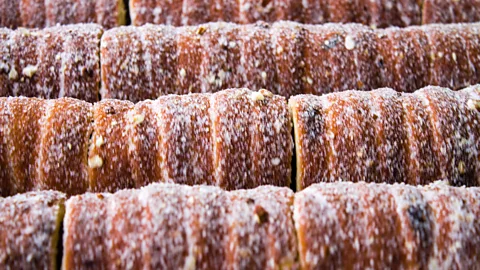 Alamy
AlamyThe trdelník can be seen as a way to appease travellers seeking out something that appears to be authentically Czech – a sugar-coated symbol of how tourism has transformed the city into something it didn't use to be.
Juliana Fischerová, a baker and food writer, said, "The trdelník likely made its way to Prague because of the festival circuit, such as Christmas markets, which was the only time Czechs would see the pastry up until recent times."
Fisherová first started seeing trdelník pastries spinning on sticks in Prague about 20 years ago and remembered she had seen the pastry in Slovakia long before that. "In Prague, it's half the size and twice the price," she said. "The worst crime, though, is that they use very low-quality ingredients at the trdelník shops in Prague. And don't get me started on the quality of the ice cream."
Fischerová says that it won’t be long before the pastry enters the canon of Czech cuisine. "Fried cheese isn't inherently Czech either, but it's been eaten here so long that it's now part of our culinary tradition. [It's] on every pub menu all over the country and, with the exception of Czech food historians, no one questions the authenticity of it."
"Authenticity" is a word that popped up over and over in my research on the trdelník. The problem is that "authenticity" is a social construct, a subjective term based on a collective perception, so what may seem authentic to one person could feel inauthentic to another.
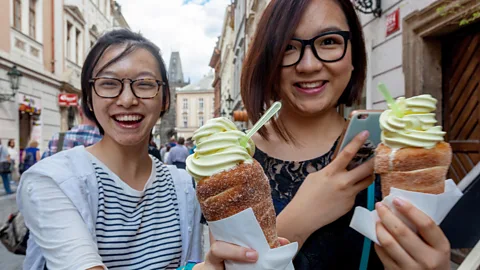 Alamy
AlamyThere was an Easter market on Prague's Old Town Square while I was visiting. And to prove Gerosa's point, I asked several trdelník stand employees if the pastry was an authentic Czech product. They all said yes. I then approached a stand selling lángos (fried bread that is indisputably tied to Hungary).
"Is lángos an authentic Czech street food?" I disingenuously asked the woman at the stall. She paused, looked me right in the eye and said, "Yes. It is traditional Czech street food. Like Czech pizza."
Trdelník purveyors in Prague are engaging in what sociologists call "impression management". By evoking an imagined historical community of costume-clad Bohemians cooking the trdelník on a stick over coals, they're not only commodifying the culture of neighbouring nations, but selling visitors a fabricated version of their own.
But does any of this really matter when hordes of tourists are literally and figuratively eating up the trdelnik? Is it really that delicious?
When I finished chatting with Rubeš at a cafe in central Prague, we walked out onto the street together. Rubeš spotted a sanitary worker emptying public rubbish bins and asked the worker, "What is the most common thing that you find in the trash in the centre of Prague?" The sanitation worker rolled his eyes and said, "Trdelník. When tourists eat through the ice cream towards the top, they just throw out the fried dough. They barely even eat the thing."
I have to confess that after witnessing the birth and extreme growth of Prague's trdelník industry over the last 20 years, I had never tasted one. So, on my penultimate day in Prague, I purchased a sugar-coated pastry (minus the add-on ice cream) at a stand at the Old Town Square. It was flaky and soft but so bland it was almost tasteless. Like nearly every trdelník-consuming tourist in Prague, I ate about half of it before it got cold and rigor mortis-like, and then tossed the rest of it in the bin.
CORRECTION: A previous version of this story incorrectly listed the country where Skalica is located. That has since been updated.
--
If you liked this story, sign up for The Essential List newsletter – a handpicked selection of features, videos and can't-miss news, delivered to your inbox twice a week.
